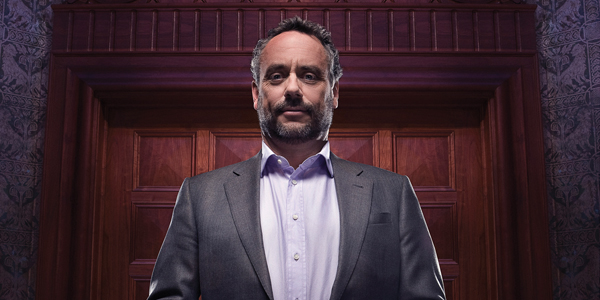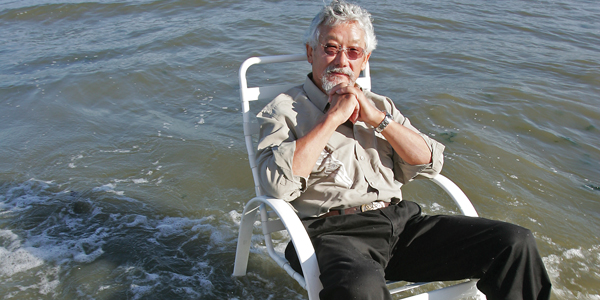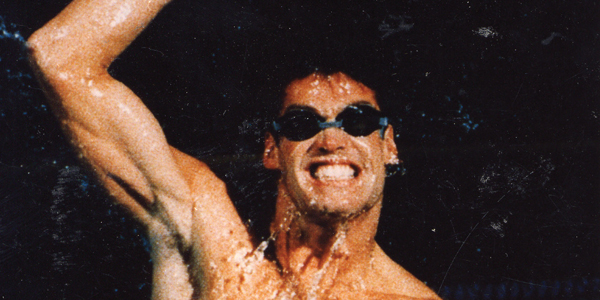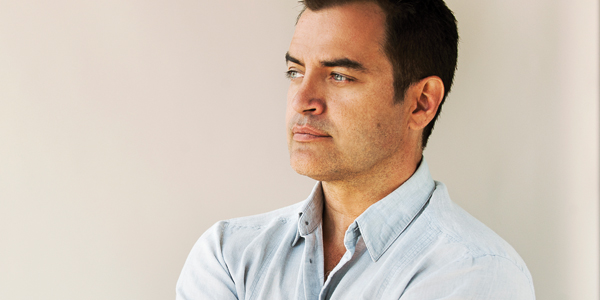I proved Stephen Hawking wrong. Whenever I say those five words during a speech, people in the audience suddenly perk up, as if a little jolt of electricity has been delivered to their seats.
I always get a kick out of that.
When I say “I proved Stephen Hawking wrong,” I’m not boasting (although, as a physicist, it’s certainly a lovely credential to have on my résumé). I say it because I know it will spark curiosity.
Curiosity is the force that drives everything I do – from getting my hands greasy under the hood of my 1979 VW van to manipulating the subatomic particles of the quantum world – and I love to inspire curiosity in others. When I say the Hawking line, I can almost see a wave of curiosity rippling through the audience: How on earth, they seem to be wondering, could anyone prove the world’s most famous physicist wrong?
The simple answer: curiosity.
There’s a complicated answer too, of course. It involves explaining how, while I was a student of Hawking’s at Cambridge University, I mathematically demonstrated that time does not reverse direction in a contracting universe, as Hawking had asserted. But let’s not wade into the murky waters of quantum theory just yet.
Instead, let’s look at how curiosity – that simple, beautiful yearning to understand the world – has guided me from a blissfully typical childhood in Québec to the forefront of science’s next great frontier.
Roughly 40 years ago, long before I became director of the Institute for Quantum Computing, I was a third-grader at a Catholic elementary school. I vividly remember the first day of math class, when the stern nun who presided over us held up a thick textbook and told the class: “We will work through this entire book; you’ll have homework every night until we have finished.”
By that logic, my young and mischievous mind reasoned, I could save myself from future homework by working through the textbook as quickly as possible. After all, math problems are just puzzles, and I loved puzzles! So off I went, textbook under my arm, on a mission: to weasel out of future homework by getting it all finished lickity-split.
A couple of weeks and lots of improvised arithmetic later, I unveiled my brilliant scheme to the nun: “I finished the textbook,” I proclaimed, “so no more homework for me, right?”
The nun scoffed: “No way. You get extra homework.”
What a rip-off, I remember thinking. We had a deal, fair and square!
In retrospect, getting assigned a truckload of extra math homework wasn’t such a bad thing, because it just meant more puzzles for me to wrap my brain around. I was a curious kid, and math provided an endless supply of mysteries for me to investigate.
It was that same innate curiosity, albeit at a more ambitious level, that led me to working with Stephen Hawking at Cambridge.
Toward the end of my undergraduate Physics degree at Laval University in my hometown of Québec City, I took an interest in the theory of quantum gravity. A mentor of mine told me that the only places to seriously pursue such a complex subject were renowned institutions such as Harvard or Cambridge.
I balked. Harvard!? Cambridge!? I’d never get accepted, I objected. My mentor shot back: “You’ll never know unless you apply.”
So I applied and – much to my amazement – I soon found myself immersed in Cambridge’s torturously difficult Mathematical Tripos program – a course from which only the top one or two students would continue to pursue PhDs with Stephen Hawking.
Fuelled by curiosity (and, I confess, a fear of failure), I worked day and night, stopping only on Sunday afternoons for a quick bike ride around the idyllic paths of Cambridge.
When final exam results were revealed – in an archaic and barbarian ceremony during which scores are read aloud from a clock tower – I was too terrified to attend.
Instead, I wandered to a nearby market to buy ingredients for dinner. To my surprise, some classmates spotted me and started yelling “congratulations!” Apparently my name had topped the list of exam scores.
My classmates told me to hurry to the math department, where I’d find out if I was eligible to begin PhD studies.
What happened next will remain forever etched into my memory. At the department office, my professor asked what I wanted to do next in my academic career.
“I’d like to study quantum gravity under Stephen Hawking,” I stammered, half-expecting the request to get quickly dismissed.
“Well,” my professor replied, “Professor Hawking is waiting for you downstairs. Go see him.”
As I descended that long staircase to Hawking’s office, I could swear the sound of my knees nervously knocking together was warning him of my approach. I had no idea how to address the world’s most renowned living physicist. Thankfully, he spoke first.
“Hi,” he said. “Congratulations. What do you want to do with your summer?”
I fumbled an answer about visiting Québec and doing some reading.
“Enjoy your summer,” Hawking told me. “Get some of my papers, read them, and I’ll see you in October when we start your research project.”
And thus began my four-year academic relationship with Stephen Hawking. During that time, his health drastically deteriorated due to his amyotrophic lateral sclerosis (Lou Gehrig’s disease), so I learned how to help him eat and get from place to place. He, in turn, fuelled my insatiable curiosity by challenging me to question everything.
One thing I questioned was his concept of the “Arrow of Time,” which he theorized would reverse in a contracting universe. Several months and thousands of calculations later, I convinced him that this postulation couldn’t be true – a revelation he graciously mentioned in his best-selling book, A Brief History of Time.
When Hawking signed my copy of the book, he wrote: “To Raymond, who showed me that the arrow of time is not a boomerang.”
I keep a framed photograph of Hawking on the wall of my office at the Institute for Quantum Computing; nearby hangs a framed photograph of my children, Patrick and Jocelyne. One picture reminds me of a man who fostered my innate curiosity, and the other reminds me of my responsibility to inspire curiosity in others.
When my kids were very small, I would often pick them up, turn them upside-down and lift them high above my head so they could “walk” across the ceiling. During these topsy-turvy strolls, I’d tell them: “It’s important to see the world from different angles.”
It’s something I tell myself every day.
Quantum physics provides a wholly different angle from which to look at the world. The quantum realm is itself a topsy-turvy world in which things behave in strange and seemingly impossible ways, such as the ability of quantum particles to be in two places at once.
These mind-boggling characteristics of quantum physics should pique the curiosity of anyone who ponders them, as they piqued mine.
Again, it was such curiosity that led me to my current role as director of the Institute for Quantum Computing, where top scientists from around the world are harnessing the weirdness of the quantum world to build a computer of unprecedented power.
As Director of the Institute, I have been entrusted with the task of making Waterloo, and thus Canada, the global epicenter of research and innovation in the emerging field of quantum computing – the next great information revolution. Other scientific institutes around the world are racing toward the same goal, but I believe Waterloo and Canada can lead the charge. To achieve this, I must provide fertile intellectual ground to nourish the curiosities of the world’s best physicists, mathematicians and computer scientists. It is only through their mutual curiosities and cross-disciplinary collaboration that we will become the world-leaders in quantum computing.
But perhaps I’m getting ahead of myself again. What, you might be wondering, is quantum computing?
I’ll spare you the math, but here’s the gist. Everyone knows computers keep getting smaller – from the elephantine vacuum-tube contraptions of the 1950s to the tiny handheld devices of today. A concept called Moore’s Law, named after Intel co-founder Gordon Moore, dictates that the number of transistors that can be crammed onto a microchip doubles every two years. That means transistors will become microscopically – even subatomically – small, at which point the peculiar laws of quantum physics will kick in.
If science can learn to control those subatomic particles, which have that dizzying ability to be in multiple states at once, it will be possible to build computers capable of an unprecedented number of calculations simultaneously. Such a breakthrough will undoubtedly revolutionize the way we understand, share, store and communicate information.
Quantum computers don’t exist yet – at least none sufficiently powerful to outperform the “old-fashioned” computers of microchips and binary data. Every single day, however, through research and experimentation, scientists bring quantum computing closer to fruition.
People often ask me what these ultra-powerful quantum computers will be used for, what they’ll look like, or how much they’ll cost. I always reply honestly: “I don’t know”. Just as the prehistoric humans who first harnessed fire couldn’t possibly have foreseen steam engines or rockets, I can’t predict what innovations will be made possible by harnessing the elements of the quantum world.
Sometimes it’s OK to not know the answers.
I didn’t know the answers to my Grade 3 math problems until I sat down and started crunching numbers. I never would have dreamed I could debate cosmological physics with Stephen Hawking until an intellectual yearning led me to his office. Likewise, I have no idea what the future will hold for quantum computing or any branch of science – but I certainly am curious.






